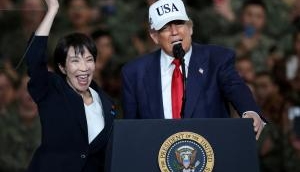
After 19-year-old Nikolas Cruz opened fired with an assault-style rifle at Marjory Stoneman Douglas High School in Florida, killing 17 people and injuring more than a dozen others, people are seen asking the same questions: What kind of person could open fire on innocent children? Why do such incidents keep happening? And what can we do to prevent such crimes?
These questions take us back to Donald Trump's assessment of Stephen Paddock, who shot nearly 600 people, leaving 58 dead, during a concert in Las Vegas in 2017, “A sick, demented man.” Echoing Trump's rhetoric, stats compiled by Gun Violence Archive, show that mass killings are mostly an American phenomenon.
Nearly a third of the world's mass shootings take place in the United States. Put another way: While the United States has about 5% of the world's population, it has witnessed 31% of all public mass shootings. Also, people have a greater chance of dying in mass shootings if they're at school or place of business, reveal studies.
In the aftermath of a mass killing, the public naturally seek to understand the shooter's motives. Their first instinct is to assume that the killer must be mentally deranged somehow. He must be a sadist who takes pleasure in the suffering of innocents or a psychopath who feels no empathy for his victims. How else could someone commit such an awful atrocity?
Reasons for such killings
US opinion polls show wide agreement that gun violence—and more specifically mass shootings—reflect problems in identifying and treating mental health. A study by American Psychological Association states that rejection can create violence in some people. Individuals who feel isolated and rejected are more likely to behave in harmful and hurtful ways.
But psychologists say research over the last three decades has consistently shown that diagnosable mental illness does not underlie most gun violence.
In studies of school shootings, findings have determined that social exclusion is often linked to aggressive acts. Similar seems the case of Cruz - a troubled former student of the high school, who loved guns and was expelled for unspecified disciplinary reasons.
Having said that we don't know when another gunman will unleash a hail of gunfire on innocent children and people. So what can be done to identify such criminal minds?
Profile of a shooter
Many mass shootings are motivated by revenge or envy. That's why many take place at a school or a workplace where shooters felt rejected, say psychologists. Despite that, it's difficult to predict who will kill and who won't. Millions of people will feel disaffected and vengeful, and may even lack empathy, but the vast majority would never shoot defenseless, says research.
Findings suggest that school shooters often harbor anger and paranoid delusions, have low self-esteem and hang out with an outcast group. And there is usually a triggering event - a history of abuse, infective parenting, sadistic streak, lack of compassion or a reason for revenge. They also tend to be obsessed with guns, violent video games or movies.
And if fascination with violent media and guns were predictive, the average ninth-grade boy could be considered at risk. Having said that, what can be done to avoid such mass killings?
Mental Illness vs Gun Violence
In their book Gun Violence and Mental Illness, psychiatrists Liza Gold and Robert Simon summarize the evidence debunking the myth that mental illness is a leading cause of gun violence. As they report, less than 5% of shootings are committed by people with a diagnosable mental illness. Which means only one percent of the population is psychopathic, and only one percent of the population is schizophrenic, and sadism is so rare there is no agreed upon psychiatric diagnosis for it.
Believing that mental illness causes mass shootings can feel reassuring. It helps to believe that only a mentally ill person could do something so horrific. We also think that if someone is mentally ill, they can be identified. But the evidence suggests that mental illness only causes a small fraction of gun violence. And even if some shooters have undiagnosed mental illness, there is no evidence to suggest that they could have been diagnosed prior to their gun violence or that such a diagnosis would increase the predictive validity of a diagnosis on gun violence.
Perpetuating the myth that mental illness is the cause of mass shootings only serves to stigmatize the mentally ill even further. In addition, it distracts from the more difficult conversation that must be had over gun-control in America
Precaution is better than cure?
Mass shootings are among the most premeditated of crimes, often planned months in advance. Nikolas Cruz reportedly wore a gas mask, carried smoke grenades, and set off the fire alarm so that students would pour out into the hallways. Though we’ll obviously learn more in the coming days, each of these things suggests careful preparation. Lack and absence of political radicalization and hints that this “ever-evolving riot” is under way.
The public cannot simply assume that the kid filling his social-media feed with menacing pictures is just in 'a phase' or that strange obsessions with murder or mass death are morbid, but harmless. Though people need to mind their business and refrain from 'not judging' others, they need to stop being their brother's keepers and make the ethic of 'see something, say something' a vital part of their lives in such cases.
Schools, on the other hand, can opt for the 'target-hardening' approach – an attempt to fortify schools against gun violence through increased security measures. These measures may include metal detectors, lockdown policies, “run, hide, fight” training and surveillance cameras.
What we know about Nikolas Cruz
As a high school freshman, Cruz was part of the U.S. military-sponsored Junior Reserve Officers’ Training Corp program at the school, according to Jillian Davis, 19, a recent graduate and former fellow JROTC member at Stoneman Douglas High. Cruz had been held back twice and aspired to join the military.
First published: 15 February 2018, 13:43 IST







![BJP's Kapil Mishra recreates Shankar Mahadevan’s ‘Breathless’ song to highlight Delhi pollution [WATCH] BJP's Kapil Mishra recreates Shankar Mahadevan’s ‘Breathless’ song to highlight Delhi pollution [WATCH]](https://images.catchnews.com/upload/2022/11/03/kapil-mishra_240884_300x172.png)

![Anupam Kher shares pictures of his toned body on 67th birthday [MUST SEE] Anupam Kher shares pictures of his toned body on 67th birthday [MUST SEE]](https://images.catchnews.com/upload/2022/03/07/Anupam_kher_231145_300x172.jpg)






